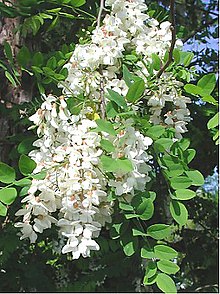Black locust
| Black locust | |
|---|---|
 |
|
| Flowers | |
| Scientific classification | |
| Kingdom: | Plantae |
| (unranked): | Angiosperms |
| (unranked): | Eudicots |
| (unranked): | Rosids |
| Order: | Fabales |
| Family: | Fabaceae |
| Subfamily: | Faboideae |
| Tribe: | Robinieae |
| Genus: | Robinia |
| Species: | R. pseudoacacia |
| Binomial name | |
|
Robinia pseudoacacia L. |
|
 |
|
| Natural range | |
Robinia pseudoacacia, commonly known in its native territory as black locust, is a medium-sized deciduous tree native to the southeastern United States, but it has been widely planted and naturalized elsewhere in temperate North America, Europe, Southern Africa and Asia and is considered an invasive species in some areas. Another common name is false acacia, a literal translation of the specific name (pseudo meaning fake or false and acacia referring to the genus of plants with the same name.) It was introduced into Britain in 1636.
The name 'locust' is said to have been given to Robinia by Jesuit missionaries, who fancied that this was the tree that supported St. John in the wilderness, but it is native only to North America. The locust tree of Spain (Ceratonia siliqua or carob tree), which is also native to Syria and the entire Mediterranean basin, is supposed to be the true locust of the New Testament.
Robinia is now a North American genus, but traces of it are found in the Eocene and Miocene rocks of Europe.
The black locust is native to the eastern United States, but the exact native range is not accurately known as the tree has been cultivated and is currently found across the continent, in all the lower 48 states, eastern Canada, and British Columbia. The native range is thought to be two separate populations, one centered about the Appalachian Mountains, from Pennsylvania to northern Georgia, and a second westward focused around the Ozark Plateau and Ouachita Mountains of Arkansas, Oklahoma and Missouri.
...
Wikipedia

